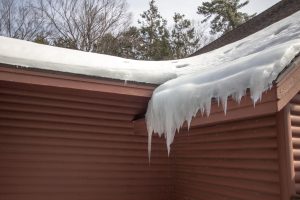
Icicles on a roof with water dripping from below on home exterior.
Winter is almost here. It’s time to get prepared for snow, ice, and all the issues that can come along with them. If you don’t know how to prevent and avoid ice dams, we have the solution for you.
How Do Ice Dams Form?
Ice dams and icicles form when snow melts, it runs down your roof, and refreezes near the edge. This occurs when part of your roof is warm enough to melt the snow and the edge of the roof remains below freezing. Typically it is a result of a warm attic. In most homes, heat escapes into the attic which warms the wood and shingles above it. It results in melting the snow directly above the attic causing the water to run to the roof’s edge where it refreezes creating a rim of ice. The rim of ice can trap more water behind it, and you have an ice dam on your hands.
How To Prevent Ice Dams On Your Roof
Removing ice dams can be a headache to homeowners, so it’s important to prevent them from forming. The best and easiest way to do this is to keep your attic and roof cold. In order to keep your roof cold, you’ll want to follow these 3 steps:
Close up all attic bypasses
About one-third of heat loss can be attributed to hot air escaping through the ceiling into the attic. Most of that heat loss comes from air leaks from unblocked walls, gaps in drywall, and cracks around chimneys, light fixtures, access hatches, plumbing pipes, and more. To close up all the bypasses, you’ll need to go into your attic and plug the leaks.
Measure your home’s attic insulation level
While you’re in the attic, it’s a good idea to measure the depth of your home’s attic insulation levels. It’s a good idea to add more insulation if you have less than 8 inches and have had ice dam issues in the past.
Add roof and soffit vents to your home
A home’s attic ventilation will draw in cold outdoor air and flush out warm attic air. This cools the attic and roof in the process. Figuring out where to add vents to help flush out the air can be a bit complex. A good rule of thumb is to put an 8 inch x 16 inch vent in the underside of the overhang in every other rafter space.
Now is the time to get your roof prepped for the winter snow. We’d love to help you make sure your attic and roof are in shape to prevent ice dams from forming. At Precise Exteriors, we serve the Twin Cities and Northwestern Wisconsin. Contact us today to get help with your attic and roof!
